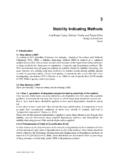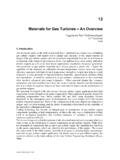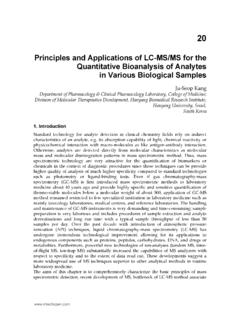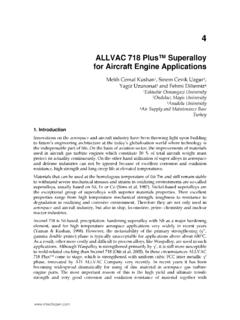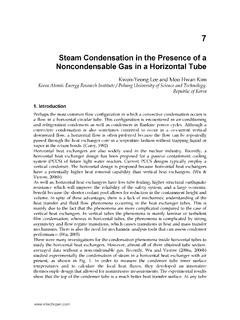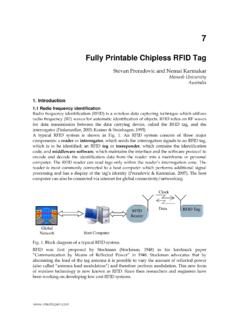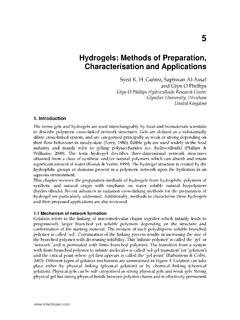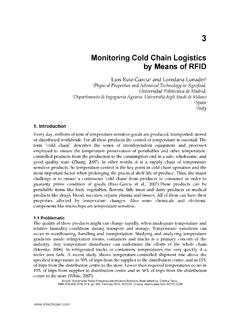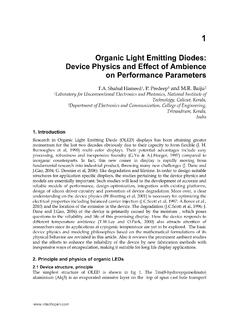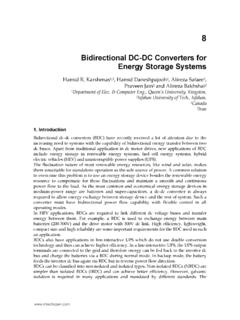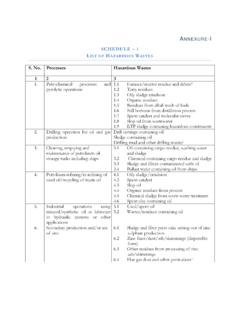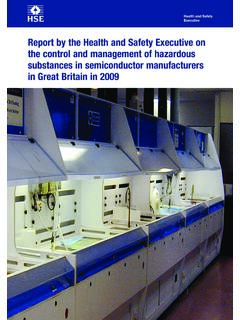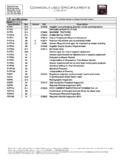Transcription of 4 Contamination monitoring and analysis in …
1 Contamination monitoring and analysis in semiconductor manufacturing57 Contamination monitoring and analysis in semiconductor manufacturingBaltzinger Jean-Luc and Delahaye Brunox Contamination monitoring and analysis in semiconductor manufacturing Baltzinger Jean-Luc and Delahaye Bruno Altis Semiconductor France 1. Introduction: Contamination on wafers Definition of the different type of Contamination Contamination is defined as a foreign material at the surface of the silicon wafer or within the bulk of the silicon wafer. The Contamination can be particles or ionic Contamination , liquid The mechanism of Contamination of silicon wafer is summarized on figure 1 (Leroy, 1999): The source of Contamination The transportation of the Contamination The location of the Contamination : surface, bulk The evolution of the Contamination : how to remove it?
2 Does the cleaning remove the Contamination ? Does the cleaning bring the Contamination ? The chemistries of the cleaning solutions which are described within the figure 1 are able to remove particles or metallic Contamination . They can also bring both of these contaminants. In this discussion, we just want to underline the source of Contamination , and the way to measure it. Another way to consider wafer Contamination source is the environment of the wafer (Pic, 2006): Contact with the wafer: chemicals, Gases, Ultra pure Deionised Water, resist, ionic implantation, deposition layers, etching process Environment for the process: tool, network for gases and chemicals distribution, boxes for wafer handling and transportation.
3 General environment: facilities, human, external pollution (traffic, industrial) Semiconductor devices are sensitive to the Contamination , due to different possible root causes: device size reduction, device sensitivities on some process steps, cross Contamination induced by chemicals, ultra pure water and gases. The environment is also contributing to the Contamination effect on the wafer as tools, transportation boxes, and clean-room. Contamination can be divided in three categories: ionic Contamination , airborne molecular Contamination (AMC) and particles (defect density).
4 In this chapter, after a short description of the different Contamination impact on wafers, we focus on metallic and anions Contamination measurements with some examples. Then the Technologies58 second part of this chapter will consider the particle monitoring on bare wafers and patterned wafers. Fig. 1. Contamination workflow: mechanism and questions. Source of Contamination : Foreign materials: Fluid impurities : chemicals, gas Tools impurities: corrosion, outgasing, handling Particles : suspensions within fluids, abrasion, Parasitic reactions Between reactive materials Corrosion, outgasing, dissolution of tool parts Transport of the Contamination : Brownian movement and convection, molecular diffusion, chemical diffusion, electromagnetic diffusion Adherence and surface phenomena : Chemical bounding(covalent, ionic, van der waals, hydrogen) Surface tension.
5 Capillarity, electrochemical effects Wetting according the surface layer (Silicon, Silicon oxide, polymer, Silicon nitride Contamination within the bulk of the silicon wafer: Implantation: ionic implantation or plasma induced implantation Diffusion during hot process Through deposition process: Cleaning effect: how the Contamination is removed? What Contamination is brought up during the cleaning steps? Cleaning solutions as SC1, SC2, HF, piranha Surface state: hydrophobic or hydrophilic Mechanical actions: brush, megasonics, jet rinse, bath motion Chemical actions: Impurity oxydo-reduction reaction Basis / acids dissolution Surface pitting Particles removals Filtration for particles and/or ionic Contamination Gettering.)
6 Capture of the defects outside the active area of the components Precipitation of the defect on the backside of the wafer Precipitation of the defect due to oxygen precipitate Charges within dielectric films as doped silicon films(Phosphorus Silicon Glass, Boron Phosphorus Silicon Glass) and Silicon Nitride films. Contamination impact on wafers The Contamination impacts of the three different contaminants are summarized in table 1 Contamination Classification Elements Sources Wafer effects Ionic contaminant Alkaline Na,K Human pollution Works Chemical and gases Electrical instability gate oxide leakage retention Ionic contaminant Transition Metals Ni,Co,Fe.
7 Human pollution Works Chemical and gases Networks tools-process Gate oxide integrity (GOI) degradation Ionic contaminant Dopants Al, P, In, Ga, As, B,.. Process: wet processes, implantation / Works Material out gassing Chemicals and gases Shift of voltage threshold of the transistor device. Ionic contaminant & Air molecular Contamination Acids F-, Cl-,CH3 COO-,Br-, PO4--,SO4-- Process pollution: etch, wet process, Chemical Vapor Deposition (CVD) Works Material out-gassing Traffic pollution Industrial pollution Pad corrosion Aluminum corrosion Defectivity on Deep UV (DUV) and Mid UV (MUV) resist Salt deposition on lens, masks, wafers Ionic contaminant & Air molecular Contamination Bases NH3 Amines Process pollution: etch, wet process, CVD deposition.
8 Works Material out-gassing Traffic pollution Industrial pollution Footing on DUV resist Salt deposition on lens, masks, wafers Photolithography activation especially with 193 nm process Organics Organics Process pollution: Wet process and lithography process Photolithography activation especially with 193 nm process. Eg: Contamination with solvent on resist Particles Organics Process Pollution: dry etch polymers, resist strip, wet process, Material out gassing Chemicals and gases Gate oxide integrity High resistivity contact Deposition on surface, lens degradation Defectivity with opens or shorts on pattern wafers Particles inorganic Process Pollution.
9 Dry etch polymers, resist strip, wet process, Material out gassing Chemicals and gases Gate oxide integrity High resistivity contact Deposition on surface, lens degradation Defectivity with opens or shorts on pattern wafers Table 1. Description of Contamination source and wafer effects monitoring and analysis in semiconductor manufacturing59 second part of this chapter will consider the particle monitoring on bare wafers and patterned wafers. Fig. 1. Contamination workflow: mechanism and questions. Source of Contamination : Foreign materials: Fluid impurities : chemicals, gas Tools impurities: corrosion, outgasing, handling Particles : suspensions within fluids, abrasion, Parasitic reactions Between reactive materials Corrosion, outgasing, dissolution of tool parts Transport of the Contamination : Brownian movement and convection, molecular diffusion, chemical diffusion, electromagnetic diffusion Adherence and surface phenomena : Chemical bounding(covalent, ionic, van der waals, hydrogen) Surface tension.
10 Capillarity, electrochemical effects Wetting according the surface layer (Silicon, Silicon oxide, polymer, Silicon nitride Contamination within the bulk of the silicon wafer: Implantation: ionic implantation or plasma induced implantation Diffusion during hot process Through deposition process: Cleaning effect: how the Contamination is removed? What Contamination is brought up during the cleaning steps? Cleaning solutions as SC1, SC2, HF, piranha Surface state: hydrophobic or hydrophilic Mechanical actions: brush, megasonics, jet rinse, bath motion Chemical actions: Impurity oxydo-reduction reaction Basis / acids dissolution Surface pitting Particles removals Filtration for particles and/or ionic Contamination Gettering.)
